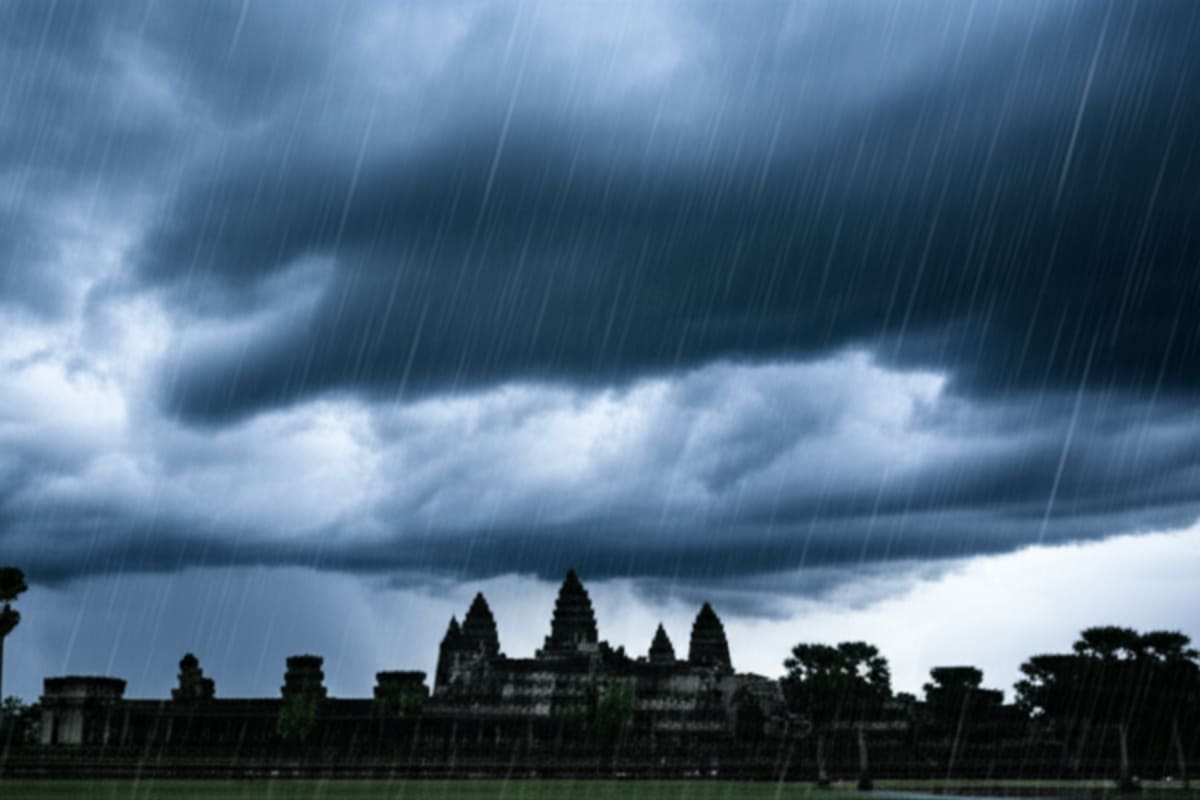Cambodia Braces for Storms and Heavy Rains (Sept 14-16)

Cambodia is bracing for a period of severe weather, with the Ministry of Water Resources and Meteorology (MWRM) issuing a forecast predicting widespread storms and heavy rains across the nation from September 14th to 16th, 2025
Background
This bulletin, released on September 14th, warns of potential disruptions to daily life, infrastructure damage, and agricultural losses, prompting calls for heightened preparedness measures across the country
This weather event coincides with the peak of the annual monsoon season in Southeast Asia, a period already characterized by increased rainfall and a heightened risk of flooding
Meteorological data indicates that rainfall averages during this period are significantly elevated, making the region particularly susceptible to extreme weather
Historical data on rainfall patterns in Cambodia during similar periods is being analyzed to better understand the potential severity of this specific forecast and to refine preparedness strategies
Agricultural Sector Concerns: The potential disruption to rice cultivation is a major area of concern. Rice is a staple food for the Cambodian population, and any significant damage to crops could have serious consequences for food security and the national economy. Agricultural experts are advising farmers to implement emergency measures to protect their crops, which may include reinforcing dikes, improving drainage systems, and applying protective treatments. However, these measures can be costly, potentially leading to reduced yields and increased financial strain on farmers.
Infrastructure Vulnerability: The forecast also raises serious concerns about potential damage to vital infrastructure. Roads and bridges in low-lying areas are particularly vulnerable to flooding, which could severely disrupt transportation networks and hinder access to essential services, including medical care and emergency assistance. Civil engineering teams are on standby to assess potential damage and initiate repairs as quickly as possible, but extensive flooding could overwhelm available resources. The long-term economic impact of infrastructure damage could be significant, requiring substantial investment for reconstruction and rehabilitation.
Climate Change Context: The MWRM's warning arrives amidst growing global concern regarding the escalating impacts of climate change. Southeast Asia has been identified by numerous scientific studies as a region particularly vulnerable to extreme weather events. Increasingly frequent and intense storms, prolonged droughts, and unpredictable rainfall patterns pose significant challenges to the region's economies and societies. Cambodia, with its heavy dependence on agriculture and its geographical location in the Mekong River Delta, is especially susceptible to these climatic changes. Scientists are closely monitoring the long-term trends in rainfall and temperature to develop more accurate climate models and inform future adaptation strategies.
Broader Sectoral Impacts: The impact of the anticipated severe weather extends far beyond the agricultural sector. Transportation networks may face significant interruptions, potentially affecting the movement of goods, people, and essential supplies. Tourism, a crucial sector of the Cambodian economy, could also be negatively impacted as visitors postpone or cancel travel plans. Disruption to power grids and communication networks is also a possibility, potentially leading to widespread outages.
Businesses operating in areas prone to flooding are strongly advised to develop and implement comprehensive contingency plans.
These plans should include measures for relocating goods, securing property against flood damage, and ensuring the safety and well-being of staff
Local authorities will play a critical role in disaster preparedness, including coordinating emergency response efforts, disseminating information to the public, and providing assistance to those affected by the severe weather
Economic and Social Consequences: The economic consequences of widespread flooding could be substantial. Disruptions to businesses, damage to residential and commercial property, and the need for extensive repairs and relief efforts will place a significant strain on national and local resources. The social impact could also be profound, with the potential displacement of populations, disruptions to education and healthcare services, and increased risks of waterborne diseases. The long-term psychological impact on affected communities should also be considered, with access to mental health services becoming increasingly important.
Public Preparedness: For the general public, preparation is paramount. Residents in vulnerable areas are urged to monitor weather updates closely through official channels and take necessary precautions to protect themselves and their property. These precautions may include securing homes against flooding, moving valuables to higher ground, assembling emergency supply kits (including food, water, medication, and first-aid supplies), and developing evacuation plans. Communicating with neighbors and family members is also crucial to ensure everyone is informed and prepared.
The Cambodian Red Cross and other humanitarian organizations are preparing to play a significant role in providing assistance should flooding or other weather-related emergencies occur
They will be mobilizing volunteers and resources to provide emergency shelter, food, clean water, and medical assistance to those affected
Donations from the public and international aid organizations will be crucial in supporting these humanitarian efforts
Government Response and Mitigation Strategies: The MWRM's forecast underscores the critical importance of robust disaster preparedness infrastructure and the effective dissemination of information to the public. Improved early warning systems, coupled with community-based disaster risk reduction strategies, can significantly mitigate the potential negative impacts of such weather events. The government's response to this forecast, including the implementation of preventative measures such as pre-emptive evacuations, reinforcement of flood defenses, and the allocation of emergency resources, will be a key factor in minimizing the impact of the predicted storms and heavy rains. The government is also working with international partners to enhance its capacity for disaster risk management and climate change adaptation.
Looking Ahead: While the forecast highlights the potential for significant disruption, it is important to note that the MWRM will continue to monitor the weather system closely and provide further updates as it develops. This detailed analysis encourages proactive steps from individuals, communities, and authorities to lessen the impact of potential disruptions and ensure the safety and well-being of the Cambodian population. The international community may also play a crucial role in providing support and resources to Cambodia during this period of potential crisis, including technical assistance, financial aid, and emergency relief supplies.
